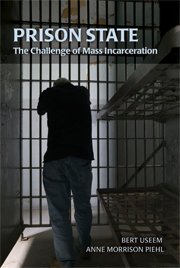Book contents
- Frontmatter
- Contents
- Acknowledgments
- 1 The Buildup to Mass Incarceration
- 2 Causes of the Prison Buildup
- 3 More Prison, Less Crime?
- 4 Prison Buildup and Disorder
- 5 The Buildup and Inmate Release
- 6 Impact of the Buildup on the Labor Market
- 7 Conclusion: Right-Sizing Prison
- Notes
- Index
- CAMBRIDGE STUDIES IN CRIMINOLOGY
6 - Impact of the Buildup on the Labor Market
Published online by Cambridge University Press: 31 January 2011
- Frontmatter
- Contents
- Acknowledgments
- 1 The Buildup to Mass Incarceration
- 2 Causes of the Prison Buildup
- 3 More Prison, Less Crime?
- 4 Prison Buildup and Disorder
- 5 The Buildup and Inmate Release
- 6 Impact of the Buildup on the Labor Market
- 7 Conclusion: Right-Sizing Prison
- Notes
- Index
- CAMBRIDGE STUDIES IN CRIMINOLOGY
Summary
The population of offenders is a relatively permanent part of American society – an “underclass” problem group that will not disappear naturally.
The U.S. economy has performed extraordinary well since the mid-1990s, in regard to unemployment. In April 2000, the unemployment rate dropped to less than 4% for the first time in 30 years. Gains for African Americans have been especially impressive. In January 1985, the black jobless rate was 15.2% compared to a white jobless rate of 6.3%, a gap of nearly 9 percentage points. In August 2007, the unemployment rate was 4.2% for whites and 7.7% for blacks. The racial gap of 3.5 percentage points is far below its 1985 level.
Recently, a number of researchers have begun to suspect a link of considerable magnitude between the declining unemployment rate and the increased use of imprisonment during roughly the same period. A related literature deals with the impact of imprisonment and wage inequality between whites and African Americans.
Labor force statistics (including the unemployment rate) play a central role in the development of formal and informal judgments about the performance of the economy and the society. Yet, these statistics exclude the institutionalized population. Incarceration rates vary greatly across geography, time, and demographic group, so whether the incarcerated population is included in these calculations can affect comparisons across these dimensions.
- Type
- Chapter
- Information
- Prison StateThe Challenge of Mass Incarceration, pp. 141 - 168Publisher: Cambridge University PressPrint publication year: 2008

